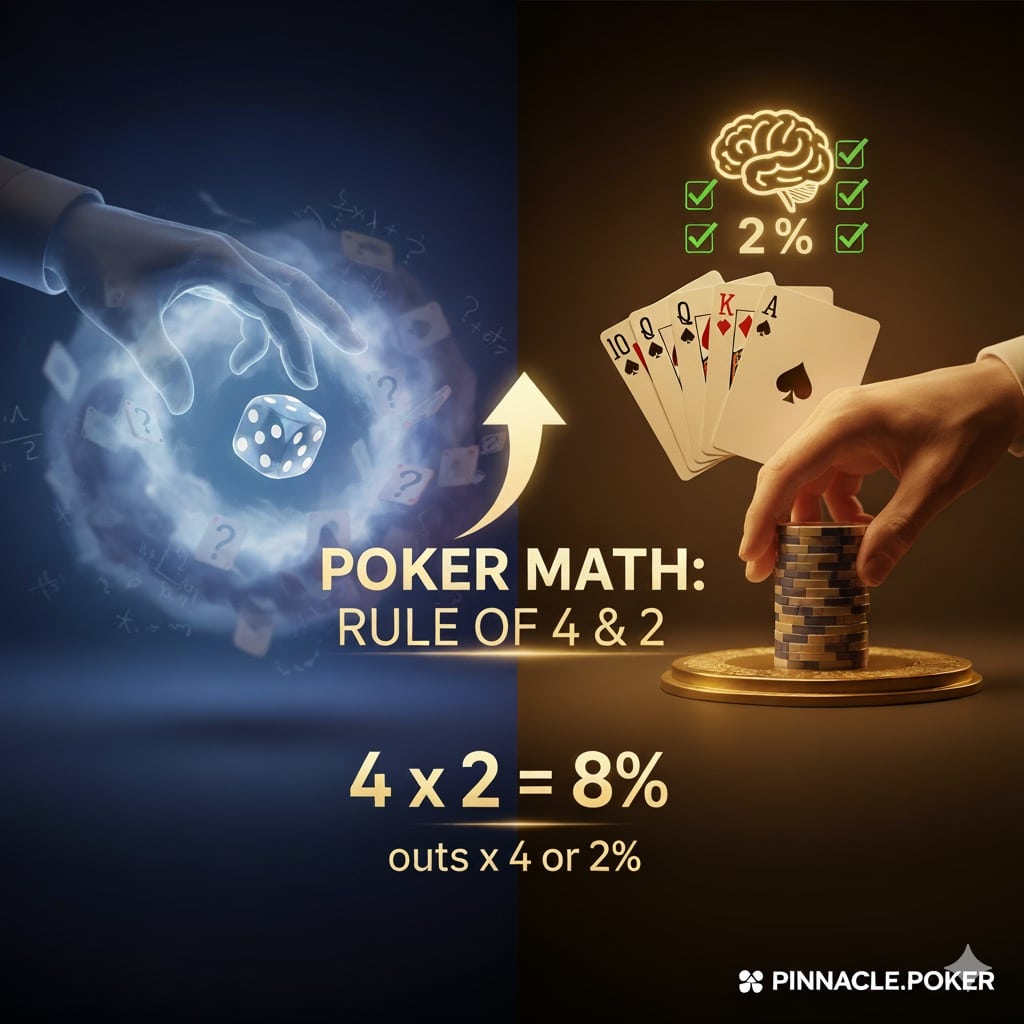
Welcome to “Poker Math Made Easy”
Welcome to the first article in our Poker Math Made Easy series. These posts are designed to give our group simple, practical shortcuts that build intuition at the table. No calculators, no long equations—just easy rules of thumb you can use in the middle of a hand to make smarter decisions.
The Question Every Player Asks
Have you ever had four cards to a straight or flush and thought:
“Should I call this bet? Am I really likely to hit my card?”
Good players don’t guess—they have a quick way to estimate their chances. The tool is called the Rule of 4 and 2, and once you learn it, you’ll always have a good sense of whether your draw is worth chasing.
The Rule of 4 and 2
Here’s the rule:
- On the flop (two cards to come): Multiply your outs by 4 to estimate your chance of hitting by the river.
- On the turn (one card to come): Multiply your outs by 2 to estimate your chance of hitting on the river.
An “out” is any unseen card that would improve your hand. If you have four hearts and need one more for a flush, there are 9 unseen hearts left in the deck—so you have 9 outs.
It’s not exact math, but it’s close enough for in-game decisions.
Examples That Actually Matter
- Flush draw (9 outs):
- Flop to river (2 cards to come): 9 × 4 ≈ 36%.
- Turn to river (1 card to come): 9 × 2 ≈ 18%.
- Actual odds: 35% and 19%. Pretty darn close.
- Open-ended1 straight draw (8 outs):
- Flop to river: 8 × 4 = 32%.
- Turn to river: 8 × 2 = 16%.
- Actual: 31.5% and 17%.
- Gutshot (or inside)2 straight draw (4 outs):
- Flop to river: 4 × 4 = 16%.
- Turn to river: 4 × 2 = 8%.
- Actual: 16.5% and 8.5%.
Common Draw Odds Chart
| Outs | Example draw | Estimated chance (turn only, ×2) | Estimated chance (flop→river, ×4) | Exact chance (turn only) | Exact chance (flop→river) |
|---|---|---|---|---|---|
| 1 | Set → quads | 2% | 4% | 2.10% | 4.30% |
| 2 | Pocket pair → set | 4% | 8% | 4.30% | 8.40% |
| 3 | One overcard hitting top pair | 6% | 12% | 6.40% | 12.50% |
| 4 | Gutshot straight | 8% | 16% | 8.50% | 16.50% |
| 5 | One pair to hit trips or two pair | 10% | 20% | 10.60% | 19.10% |
| 6 | Two overcards to hit top pair | 12% | 24% | 12.80% | 23.40% |
| 8 | Open-ended straight | 16% | 32% | 17.00% | 31.50% |
| 9 | Flush draw | 18% | 36% | 19.10% | 35.00% |
| 12 | Combo draw (e.g., overcard + FD) | 24% | 48% | 25.50% | 45.00% |
| 15 | Monster draw (FD + OESD) | 30% | 60% | 32.60% | 54.10% |
A Note of Caution: Not All of Your Outs May Be Clean
Sometimes, not all of your outs are “clean,” meaning that a card that completes your hand might also complete a better hand for someone else. The two most common examples are (1) a card that completes your straight, but another player’s flush and (2) a card that completes your flush, but pairs the board to complete a full house for another player.
Example: You hold 7❤️6❤️ on a board of A♦️-Q♠️-5♠️-4♣️. You have eight outs to make your straight, but two of them (the 3♠️ and 8♠️ may not be clean, because the other player may have two spades in their hand).
So, two final things to think about when chasing your draws:
- If there are two (or, worse, three) cards of a suit on the board, be a bit more cautious when chasing your straight draws.
- When there is a pair on the board, be a bit more cautious when chasing your straight or flush draws.
Takeaway Challenge for Next Game
The next time you flop a draw:
- Count your outs.
- Multiply by 4 (if on flop) or 2 (if on turn).
- Say the % to yourself before acting.
Do this just once or twice during the night, and you’ll immediately feel more confident in your decisions.
Have a Poker Strategy or Math Question You Want Answered?
These Poker Math Made Easy posts are here to give you shortcuts you can actually use at the table. If you have questions—or a topic you’d like covered—please leave a comment below the post or contact me directly and I’ll cover it in a future post.
